 For three full days and nights earlier this week, an NDTV team comprising Barkha Dutt, me, two camera persons, a producer, two OB personnel and an engineer travelled about 680 km along parts of the Line of Control (loC) in the Kashmir Valley and Jammu regions. This is a compilation of our experience in what is a “hot peace” as an Army officer described it! Read on.
For three full days and nights earlier this week, an NDTV team comprising Barkha Dutt, me, two camera persons, a producer, two OB personnel and an engineer travelled about 680 km along parts of the Line of Control (loC) in the Kashmir Valley and Jammu regions. This is a compilation of our experience in what is a “hot peace” as an Army officer described it! Read on.
DAY I: Srinagar-Uri-Srinagar
The majesty of the Pir Panjal mountains. The full flow of the Jhelum river. The stillness of the mountain air, the tranquility all around belies the fact that we were in a major military flash point. One that has sometimes taken India to the brink of war.
We are in the Uri sector of the Line of Control, the 776 km de facto border separating India from Pakistan. For almost ten years now a ceasefire agreement between both countries has more or less held. But a spate of recent violations has renewed tensions all along the LOC. And as the soldiers here will tell you. Ceasefire or not the constant threat of imminent danger means the mind must be battle ready at all times.
Beyond Uri town a kuccha road winds its way up and down the mountain slope over gravel, mud and loose stones. To the border outpost of Silikote, the last village near the LoC. From here we begin our walk up to the forward post. In easy line of sight of the Pakistani troops on the other side of the LOC

Life at the LOC is often a test of nerves. Motivation and morale is key. As we clamber up the sparsely populated mountain ridge, we see some of the slogans that keep the soldiers strong.
Dar Sab ko lagta hai, Dar ke aage jeet hai, says one ( Everyone is scared says one. But beyond fear is victory).
Paanch minute, paachas gola (5 minutes, 50 rounds), says another.
After the ceasefire the focus has shifted more to counter infiltration strategies. But the soldiers tell us that whether its the ammunition levels, the regular shooting practice, the 24 hour patrolling or the underground communication trenches and observation posts life for them is akin to navigating a high tension wire.
For the 27 families. Roughly 100 people who live in Silikote village every ceasefire violation is a memory too close to the bone. The very sound of gunfire can still trigger tears.
Irshad Ahmed was just 18 when an artillery shell from the Pakistani side cut through his leg and left him permanently disabled. Today as he shows us his injuries his eyes well up. He tells my colleague Barkha Dutt he had got recruited into the army just days before the firing across the line of control changed his life forever. But the tragedy of this family was further compounded. Irshad introduces us to his father Ghulam Qadir.
We discover that shortly before the ceasefire agreement came into place and two years after Irshad was wounded.. His mother, Ghulam’s wife was killed while she had taken the cattle out to graze.
But there is no space available to the soldiers to mourn when one of their own dies. They must remain not just vigilant but stoic as they guard the honour of the flag and stand alert for surprise firing from the other side.
 We are finally at the closest point possible to the line of control. The waterfall in the distance separates Pakistan from India.
We are finally at the closest point possible to the line of control. The waterfall in the distance separates Pakistan from India.
The truth is that even after the ceasefire, life on the Line of Control can often be about walking a thin line between conflict and peace.
When the headlines of a LOC violation fade and the country turns its gaze away, the soldier is still standing right there. Never betraying loneliness or vulnerability, as he keeps a watchful eye over the final frontier of the nations boundaries.
For residents of the Silikote village, access to education and livelihood is a luxury. Vocational training facilities are a far cry but Nisar Ahmed and Atiq are lucky.
An initiative by the local army unit has allowed them to undergo training in hotel management opening up employment opportunity they would not have dreamt of.
Says Nisar: “I did this hotel management course jointly organised by IHM (Institute of Hotel Management) and the Army. After the course I got a job in Taj Vivanta in Srinagar.”
Manzoor and Atiq are not alone.
Over the past two years over 100 boys have been imparted hotel management courses, thanks to these two instructors.

Hotel management graduates and civil services aspirants Sohail and Manzoor have camped in Uri to run this vocational course. Says Sohail: “
The Army has opened this centre where we train these boys in learning various hotel management skills. We have come from IHM Srinagar.”
Not just these boys, but for all villagers life without Army’s support would be tougher.The Army helps the residents in various ways: provides medical help, builds playgrounds, supplies computers to schools.
The Sarpanch is emphatic: “The Indian Army is our saviour. It gives us a reason to hope.”
In absence of any state government presence here the Indian Army is indeed the saviour for this area.
DAY II: Srinagar-Shopian-Pir ki Gali-Surankote-Krishna-Ghati-Nangi Tekri


A quick meeting with 15 Corps Commander. Lt. Gen Gurmeet Singh and we set off for Shopian, the start of the Mughal Road, the old route between Balfliaz, south of Pir Panjal and the Kashmir Valley to it the north of Pir Panjal, now reconnected by a brand new road. But journeys in Kashmir are never smooth. There is trouble at Pulwama and Shopian, we are told. People are angry at the killing of four civilians in Shopian, two days before our journey. The CRPF claimed all four were militants. Locals differ. They have called for a protest. Stone pelting is happening on the way. We are told to be cautious but running against time we decide to take our chances.
Our driver knows the by lanes in south Kashmir and takes us on a detour to avoid troubled areas. It adds nearly 40 km to our journey. But every miles is worth the delay. As we reach Shopian, bypassing Pulwama, the streets are deserted, stones are strewn all over.

A quick shoot of the billboards, shut down shops and security forces, we get away as speedily as possible and hit the beauteous Mughal Road. Officially still not open to traffic, taxis and security force vehicles have started plying on the road, wide and winding through some of the most spectacular mountains. It starts to rain and the trouble begins.
The still-not-stabilised mountains hurl stones–big and small–on the road. One of our vehicles has a narrow escape as a large boulder whizzes past inches away from its bonnet!
A board makes us stop in our tracks. We stop an Army Captain leading a security detail to ask what dose Aliabad Sarai mean. He explains. During the Mughal era, convoys used to traverse this route. The convoys used to rest every night. One such major halt was at Aliabad. The ruins of the Sarai (a roadside Inn, if you may) are still visible down in the valley from where we are standing.

 The intensity of the rain increases. Fog envelopes the road. Visibility is down to a metre! Our speed is reduced to less than 10 km an hour. Pir ki Gali, the Pass that connects the two valleys is is a non-descript highest point on the road. As we roll down the slope towards Bafliaz and into the Surankote-Poonch area, our thoughts are on the evening programme. Mobile connectivity is erratic. Sometimes for long stretches there is no signal. So we use primitive methods to communicate with Delhi through the OB (outdoor Broadcast) Van by holding handwritten placards while the Delhi MCR (Master Control Room) speaks through the OB!
The intensity of the rain increases. Fog envelopes the road. Visibility is down to a metre! Our speed is reduced to less than 10 km an hour. Pir ki Gali, the Pass that connects the two valleys is is a non-descript highest point on the road. As we roll down the slope towards Bafliaz and into the Surankote-Poonch area, our thoughts are on the evening programme. Mobile connectivity is erratic. Sometimes for long stretches there is no signal. So we use primitive methods to communicate with Delhi through the OB (outdoor Broadcast) Van by holding handwritten placards while the Delhi MCR (Master Control Room) speaks through the OB!
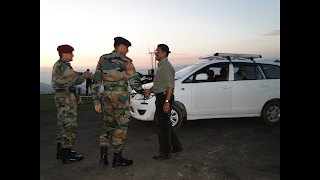 At last we reach Krishna Ghati brigade of the Army!
At last we reach Krishna Ghati brigade of the Army!

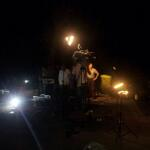 We decide to go live from here. Barkha anchored her programme from Krishna Ghati that evening. But the day was not over.
We decide to go live from here. Barkha anchored her programme from Krishna Ghati that evening. But the day was not over.
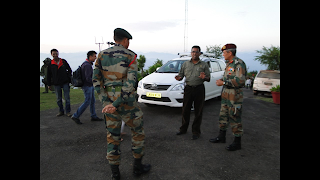
The army has a surprise lined up for me! Its my 51st birthday and one of my students from the Staff College, now G-1 at the KG brigade, rustles up a cake.
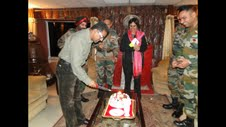
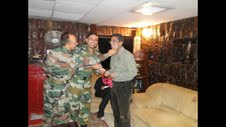 For the first time in my 51 years, I cut a birthday cake. A quick dinner and we are off to Nangi Tekri a forward post under the brigade which has seen more than a dozen ceasefire violations in August-September this year. Its 11.30 pm. We have been on our feet since 7 am!
For the first time in my 51 years, I cut a birthday cake. A quick dinner and we are off to Nangi Tekri a forward post under the brigade which has seen more than a dozen ceasefire violations in August-September this year. Its 11.30 pm. We have been on our feet since 7 am!
Under the gentle glow of a half moon.To the naked eye, the softly shimmering lights in the distance look like a giant garland has been draped over the ridge line.
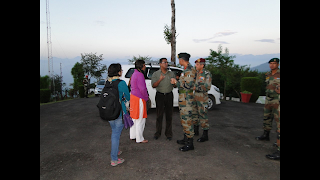
On our camera its barely visible. But these blobs of white light are actually part of India’s fence at the line of control. And just beyond it is Pakistan.
From Krishna Ghati.. which has seen some of the of the worst ceasefire violations recently.. We head out to see the fence, a game changer f security at the LoC.
Night time of course is especially precarious. Both for firing across the boundary as well as infiltration. And as we drive through the darkness, we are told that we are literally driving parallel to Pakistan’s observation posts on the other side of the line.
Half hour later we are at Nangi Tekri, a dominating height taken by India in the 1971 war. Just at this one post there have been 15 ceasefire violations this year alone. Tonight at first, all seems quiet. In fact, its almost eerily still. All one can hear in the distance is night sounds of crickets.
But there’s no taking any chances. In an underground bunker, surveillance is never let up. Not even for a second. From radio intercepts to battle field radars, all keep an eye on the other side. At this moment. The screen picks up some movement. Is it cattle? Is it a vehicle? Is it some one else ? Every minute detail must be reported..
Outside, the night is still silent. And then suddenly in the distance, the sound of gun shots, faint at first, louder later. Small arms fire. That, the soldiers tell us, is speculative firing by the Pakistanis.
Every night at this post, more than 200 such rounds of speculative fire can be heard. Too faint to register on camera but clear to the ear in the stillness of the night.
We make our way slowly down to the fence. Over patches of mud and stone to reach the last concrete barrier against Pakistani intruders. Across the barbed wire fence lies the Rokar Ridge in Pakistan.
The fence is patrolled 24 hours. The night patrols are especially strenuous. Almost a mind game.. Because the brain needs to be alert even if a leaf so much as rustles.
A few times every night, soldiers on duty approach from opposite sides to meet at the fence. They will need to confirm that there has been no breach. No suspicious movement. A message that is then conveyed to their superiors.
How difficult a 776 kilometre stretch is to secure, especially at night becomes evident to us as we move up. Standing right next to the fence and even walking right past him we don’t even see the ghatak team of the unit, crouched behind a tree! His weapon ready to shoot if needed.
And till he emerges from under the green and reveals himself to be a soldier nor do we see a sniper in camouflage. He sometimes stays in one position from the crack of dawn till night breaks.
In a pitch dark, thickly forested terrain like this sometimes all the conventional systems of surveillance may not be sufficient.
When there is apprehension of an intrusion or a movement detected on the Indian side of the LOC not verified by other systems mortars would have to deployed to illuminate the area.
These few seconds of available light could be used if there is an actual violation of territory to hit the target with rocket launchers. Such is the level of vigilance and high tension every night at forward posts.
Clearly for all of us who sleep safely at home, are thousands who stay awake at risk to their own lives making a new dawn possible every single day.
Its 2.45 am. Time to hit the bed. Exhausted but happy with a full, productive day (and night).
Day III: KG-Mendhar-Balakote-Hamirpur
It looks like any other mountain village. The women chatting as they take the cattle out to graze.. The men busy in the maize fields.
But the miles of wire that encircle it and the soldier’s post right at the beginning of the narrow path that takes you down into the village. Of Goldhe are signs of the permanent anxiety that stalks the people here.

This village right on the line of control has been witness to the surge in ceasefire violations. The red and green flags dug onto the roofs indicate where the last round of mortar shells fell from across the border.
The women tell us they worry they most for their children.. But they are too poor to move out into any other area.
The sudden spate of LoC violations and especially the killing of five Indian soldiers has made the almost ten year old ceasefire agreement vulnerable. So far the firing has been restricted to small arms and mortar. The concern now is how to avoid an escalation to artillery duels across the boundary.
While ceasefire violations may have become a mere tabulation of statistics in the media, on the ground they can mark the difference between life and death.
The one thing though that has made guarding the frontiers somewhat more efficient is of course this fence that runs along the entire stretch of the LOC.
Today taken for granted as an element of the national security apparatus. But few remember what a mammoth project it was to construct and the firing that it provoked across the border
The terrain and the weather, especially heavy snow means looking after the fence is a 24 hour challenge. Every 50 yards along the fence is a soldiers post.When it was built.. the Army spent more than 2000 crore rupees on what was Operation Deewar. now just keeping it in good shape costs 25
Crores a year.
But the fence is still not the final frontier. The last man standing is still the soldier. Often in eye ball to eyeball contact with Pakistani troops on the other side.
As day turns to night his job never ends.
 For three full days and nights earlier this week, an NDTV team comprising Barkha Dutt, me, two camera persons, a producer, two OB personnel and an engineer travelled about 680 km along parts of the Line of Control (loC) in the Kashmir Valley and Jammu regions. This is a compilation of our experience in what is a “hot peace” as an Army officer described it! Read on.
For three full days and nights earlier this week, an NDTV team comprising Barkha Dutt, me, two camera persons, a producer, two OB personnel and an engineer travelled about 680 km along parts of the Line of Control (loC) in the Kashmir Valley and Jammu regions. This is a compilation of our experience in what is a “hot peace” as an Army officer described it! Read on.
 We are finally at the closest point possible to the line of control. The waterfall in the distance separates Pakistan from India.
We are finally at the closest point possible to the line of control. The waterfall in the distance separates Pakistan from India. Hotel management graduates and civil services aspirants Sohail and Manzoor have camped in Uri to run this vocational course. Says Sohail: “ The Army has opened this centre where we train these boys in learning various hotel management skills. We have come from IHM Srinagar.”
Hotel management graduates and civil services aspirants Sohail and Manzoor have camped in Uri to run this vocational course. Says Sohail: “ The Army has opened this centre where we train these boys in learning various hotel management skills. We have come from IHM Srinagar.”
 A quick meeting with 15 Corps Commander. Lt. Gen Gurmeet Singh and we set off for Shopian, the start of the Mughal Road, the old route between Balfliaz, south of Pir Panjal and the Kashmir Valley to it the north of Pir Panjal, now reconnected by a brand new road. But journeys in Kashmir are never smooth. There is trouble at Pulwama and Shopian, we are told. People are angry at the killing of four civilians in Shopian, two days before our journey. The CRPF claimed all four were militants. Locals differ. They have called for a protest. Stone pelting is happening on the way. We are told to be cautious but running against time we decide to take our chances.
A quick meeting with 15 Corps Commander. Lt. Gen Gurmeet Singh and we set off for Shopian, the start of the Mughal Road, the old route between Balfliaz, south of Pir Panjal and the Kashmir Valley to it the north of Pir Panjal, now reconnected by a brand new road. But journeys in Kashmir are never smooth. There is trouble at Pulwama and Shopian, we are told. People are angry at the killing of four civilians in Shopian, two days before our journey. The CRPF claimed all four were militants. Locals differ. They have called for a protest. Stone pelting is happening on the way. We are told to be cautious but running against time we decide to take our chances. A quick shoot of the billboards, shut down shops and security forces, we get away as speedily as possible and hit the beauteous Mughal Road. Officially still not open to traffic, taxis and security force vehicles have started plying on the road, wide and winding through some of the most spectacular mountains. It starts to rain and the trouble begins.
A quick shoot of the billboards, shut down shops and security forces, we get away as speedily as possible and hit the beauteous Mughal Road. Officially still not open to traffic, taxis and security force vehicles have started plying on the road, wide and winding through some of the most spectacular mountains. It starts to rain and the trouble begins. The intensity of the rain increases. Fog envelopes the road. Visibility is down to a metre! Our speed is reduced to less than 10 km an hour. Pir ki Gali, the Pass that connects the two valleys is is a non-descript highest point on the road. As we roll down the slope towards Bafliaz and into the Surankote-Poonch area, our thoughts are on the evening programme. Mobile connectivity is erratic. Sometimes for long stretches there is no signal. So we use primitive methods to communicate with Delhi through the OB (outdoor Broadcast) Van by holding handwritten placards while the Delhi MCR (Master Control Room) speaks through the OB!
The intensity of the rain increases. Fog envelopes the road. Visibility is down to a metre! Our speed is reduced to less than 10 km an hour. Pir ki Gali, the Pass that connects the two valleys is is a non-descript highest point on the road. As we roll down the slope towards Bafliaz and into the Surankote-Poonch area, our thoughts are on the evening programme. Mobile connectivity is erratic. Sometimes for long stretches there is no signal. So we use primitive methods to communicate with Delhi through the OB (outdoor Broadcast) Van by holding handwritten placards while the Delhi MCR (Master Control Room) speaks through the OB! At last we reach Krishna Ghati brigade of the Army!
At last we reach Krishna Ghati brigade of the Army!
 We decide to go live from here. Barkha anchored her programme from Krishna Ghati that evening. But the day was not over.
We decide to go live from here. Barkha anchored her programme from Krishna Ghati that evening. But the day was not over.

 For the first time in my 51 years, I cut a birthday cake. A quick dinner and we are off to Nangi Tekri a forward post under the brigade which has seen more than a dozen ceasefire violations in August-September this year. Its 11.30 pm. We have been on our feet since 7 am!
For the first time in my 51 years, I cut a birthday cake. A quick dinner and we are off to Nangi Tekri a forward post under the brigade which has seen more than a dozen ceasefire violations in August-September this year. Its 11.30 pm. We have been on our feet since 7 am! On our camera its barely visible. But these blobs of white light are actually part of India’s fence at the line of control. And just beyond it is Pakistan.
On our camera its barely visible. But these blobs of white light are actually part of India’s fence at the line of control. And just beyond it is Pakistan. This village right on the line of control has been witness to the surge in ceasefire violations. The red and green flags dug onto the roofs indicate where the last round of mortar shells fell from across the border.
This village right on the line of control has been witness to the surge in ceasefire violations. The red and green flags dug onto the roofs indicate where the last round of mortar shells fell from across the border.






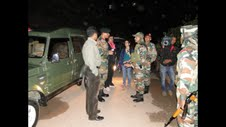
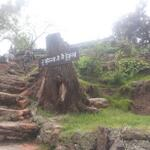

September 17, 2013 -
well documented Nitin…having served in all the areas you travelled….it was a trip down the memory lane for me !!!….Hope your pgme conveys the right msg to the countrymen and specially bureaucrats and politicians and they sanction some well deserved goodies for the armed forces….OROP, NFU etc….else the BJP govt under NaMo will do it next year when they are in power (surely) !!!